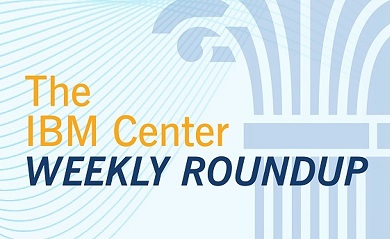
Weekly Roundup: February 10-14, 2025

Artificial Intelligence/Innovation
White House Seeks AI Input as Congress Eyes New AI Task Force. The Trump administration is seeking feedback on its artificial intelligence action plan while Congress plans its next move in AI regulation – which may include propping up a new AI task force and codifying the AI Safety Institute. In a request for information (RFI) published to the Federal Register on Feb. 6, the Office of Science and Technology Policy (OSTP) and the Networking and Information Technology Research and Development (NITRD) National Coordination Office (NCO), said they are accepting input on an AI action plan. Respondents will have until March 15 to provide input while the Trump administration develops a platform that will eliminate “unnecessarily burdensome requirements” that may “hamper private sector AI innovation…”
What Is Agentic AI, and How Will It Change Work? With their supercharged reasoning and execution capabilities, agentic AI systems promise to transform many aspects of human-machine collaboration. The agentic AI prize could be great, with the promise of greater productivity, innovation and insights for the human workforce. But so, too, are the risks: the potential for bias, mistakes, and inappropriate use. Early action by business and government leaders now will help set the right course for agentic AI development, so that its benefits can be achieved safely and fairly.
How Constructive Dissent Can Unlock Your Team’s Innovation. The key to unlocking innovation from diverse perspectives is constructive dissent: a team’s ability to engage respectfully in the exchange of conflicting viewpoints. As a norm, or pattern of shared behavior, it brings together creative abrasion, social collaboration, and emotional regulation. If a team can’t find a way to engage in constructive dissent, it will default to preserving the status quo. But if it can, that norm will unleash the team’s innovative capability. The author presents eight practical ways to nurture constructive dissent and release your team’s full innovative potential.
Workforce
OPM: 75K Federal Employees Accept ‘Deferred Resignation’ Offer. About 75,000 Federal employees have accepted the Trump administration’s “deferred resignation” offer, a spokesperson for the Office of Personnel Management (OPM). The offer allows Federal employees to resign but be paid through Sept. 30. OPM said the offer’s deadline closed on Wednesday after a federal judge lifted a pause on the program – the original deadline for employees to accept the offer was Feb. 6. The federal civilian workforce amounts to about 2.4 million people, not including military personnel and U.S. Postal Service workers. The 75,000 Feds taking the deferred resignation program amounts to about 3.1 percent of that total.
The history of federal employee buyouts, and why the deferred resignation offer is different. Whether you took the deferred resignation offer from the White House or not, everyone is paying attention to its implementation. To provide a softer and easier way to reduce the federal workforce, this is not necessarily a new idea for doing so; it’s just never been attempted on this scale before. To get some more background on it the Federal Drive with Tom Temin spoke to Elaine Kamarck, director of the Center for Effective Public Management at the Brookings Institution.
Research: A Better Way to Keep Tabs on Your Remote Workforce. As remote work continues to grow in the U.S., employers are increasingly adopting new technologies to monitor how their employees spend their time. The research on the utility of these monitoring tools has been mixed. In a new study, researchers explored the impact that different kinds of monitoring have on employees’ willingness to share new ideas. The researchers offer considerations for organizations looking to encourage creativity without weakening employee trust.
Leadership
Coach K Offers Leadership Advice for Fed AI Implementation. Former Duke Basketball Coach Mike Krzyzewski said his approach to leadership focuses on the ‘four A’s,’ which include agility, adaptability, accountability, and a winning attitude. He said the best way to be open to adapting is to ask for input from all members of a team. “As you’re implementing something new, I think it’s really important to ask force multiplier questions… that makes people feel like they belong,” Krzyzewski said. He emphasized that agility and adaptability will only work while embracing accountability throughout AI implementation. Holding people accountable means telling people the truth. “Be agile, be adaptable, hold your team and yourself accountable, and have your team hold you accountable.” Krzyzewski said.
Who Are You as a Leader? The author presents best practices for curating a multifaceted identity that will serve you well professionally and personally. At the center of this approach is the construction of what Ingram calls the identity map—a simple device that allows people to identify, visualize, and ultimately leverage the many interconnected elements that make up their sense of who they are.
The Power of Strategic Fit. The authors show how to create a cohesive strategy that unleashes the power of strategic fit. They identify seven strategic factors: the mental model, purpose and ambitions, stakeholder value creation, macro forces, markets and products, competitive advantages, and the operating model. And they explain how aligning them generates beneficial multiplier effects.
Transformation
Hill Republicans File Bill to Pave Way for Trump Reorg Plans. A bicameral pair of Republican legislators has introduced legislation that they say will restore presidential authority to reorganize the Federal government and eliminate agencies. The Reorganizing Government Act of 2025 introduced on Feb. 13 by House Oversight and Reform Committee proposes to ensure “Congress takes an up or down vote” on reorganization plans submitted by President Trump. The president hasn’t had the authority to reorganize government since 1984. Their bill would restore those abilities through December 2026 while requiring Congress to vote on Trump reorganization plans within 90 days of their submission using an expedited process that cannot be filibustered. The legislation would also prohibit reorganization plans that increase the size of the federal workforce or expenditures.
DLA CIO Talks ERP Modernization Journey. The Defense Logistics Agency (DLA) has embarked on a modernization overhaul of its enterprise resource planning (ERP) system to transition into the next generation of business processes. “In moving from our legacy ERP to the next generation, we realized that with our latest ERP, we weren’t fully utilizing the system itself due to government compliance, regulations, and unique business processes,” Adarryl Roberts, DLA’s CIO, explained. DLA’s top concern is addressing security vulnerabilities. He explained that another critical aspect in ensuring a successful modernization of ERP systems is thinking differently about the business, “such as using the technology for what it’s built for.”
Cyber
GAO Pushes Coast Guard to Beef Up Maritime Cyber Efforts. The Government Accountability Office (GAO) recommended this week that the U.S. Coast Guard update its oversight standards and cybersecurity protections for vessels and facilities within maritime transportation system (MTS) which include waterways, ports, and land connections.
Presidential Transition – Updates
Which of Trump's nominees have been confirmed? The Senate is currently vetting and voting on President Donald Trump's nominees for his Cabinet and other senior roles. There’s list of his nominations thus far and will update when they are confirmed by the Senate. There also are links to our coverage regarding how these individuals plan to lead their agencies and what workforce changes they could make.
THIS WEEK @ THE CENTER
RECENT BLOGS
- Identifying and Engaging Stakeholders by Julia Carboni. This blog series is designed to equip public leaders and managers with practical tools and strategies for engaging the public in ways that can help restore trust in government. In the first blog post, six aspects of public engagement were introduced. Today, we will discuss the third aspect of public engagement, “Identifying and Engaging Stakeholders.”
ICYMI – Exploring the Application and Use of Extended Reality. This week Michael Keegan welcomed Annie Eaton, author of THE EXTENDED REALITY BLUEPRINT to explore her insights into Extended Reality, how ER encompasses both Augmented Reality and Virtual Reality, how the public sector and government services can leverage AR/VR technology, and what the future holds for Extended Reality?



